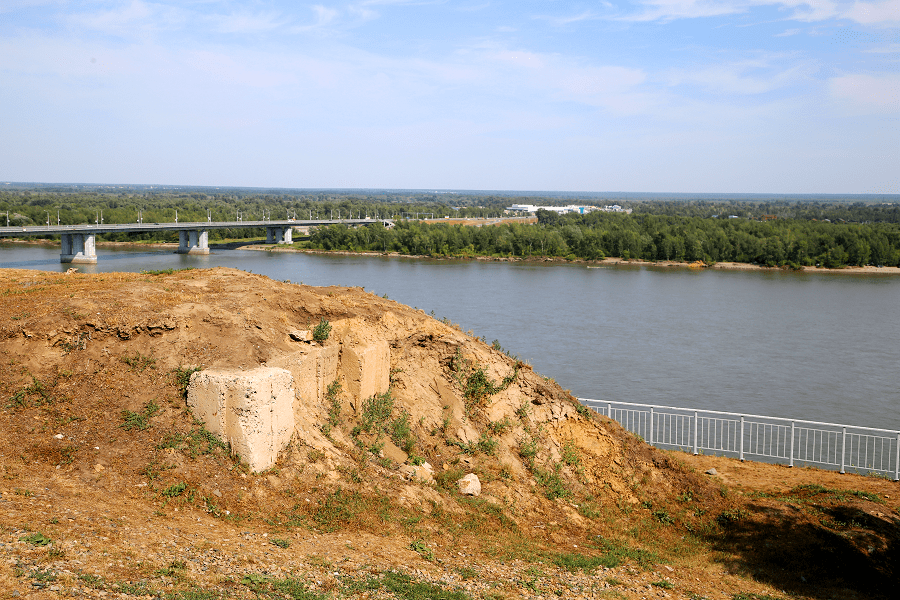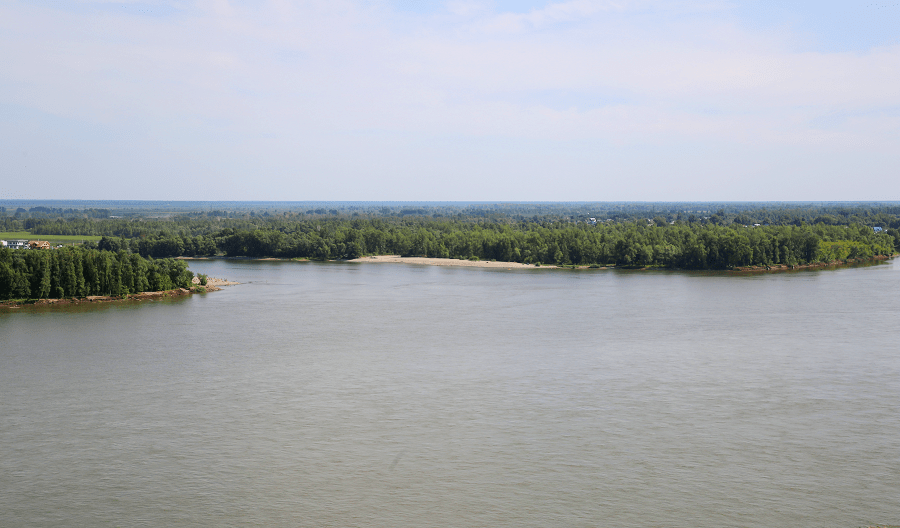The Ob (Russian: Обь) is a river in Russia that flows through Western Siberia. One of the largest rivers in the world. The length of the Ob is 3650 km (from the source of the Irtysh – 5410 km), the drainage basin area is 2,990,000 km². Water flow 287 km from the mouth (near Salekhard) is 12,492 m³/s. The average long-term flow is 403.981 km³/year. It originates at the confluence of the Biya and Katun in the foothills of Altai. At the mouth it forms the Gulf of Ob and flows into the Kara Sea.
The river is fed predominantly by snow, in Altai it is mixed: the share of snow feed is 40%, glacial 22%, rain 19% and groundwater 15%; in the taiga zone the share of snow supply is 55%, rainfall – 25%, groundwater – 20%.
During the spring-summer flood period, the river brings the bulk of the annual flow. In the upper reaches, the flood starts from the beginning of April, on average – from the second half of April, and in the lower reaches – from the end of April – beginning of May.
The rise in levels begins even during freeze-up; when the river opens up as a result of congestion, intense short-term rises in levels occur. Because of this, some tributaries may experience a reversal of flow direction. In the upper reaches, the flood ends in July, the summer low water is unstable, and in September – October there is a rain flood.
In the middle and lower reaches, the decline of the flood with overlapping rain floods continues until freeze-up. On average, the river is under ice for 180 to 220 days a year, depending on how severe the winter is.
In the southern part of the Ob there is the Novosibirsk reservoir, formed by the dam of the Novosibirsk hydroelectric power station. The dam was constructed from 1950 to 1961; During the creation of the reservoir, many villages and the main part of the city of Berdsk were flooded. The Sea of Ob (as the locals call it) serves as a vacation spot for many Novosibirsk residents; numerous recreation centers and sanatoriums are located on its shores. Tourists also come here from neighboring regions.
At the end of the 19th century, the Ob-Yenisei Canal was built, connecting the Ob with the Yenisei. It is currently unused and abandoned.
Ichthyofauna
Fishing has long been developed on the Ob. Thus, at the end of the 19th century, fishermen caught perch, ruff, goby, sculpin, pike, burbot, muksun, cheese, shokur, pyzhyan, nelma, grayling, brown trout, taimen, crucian carp, gudgeon, roach, chebak, dace, minnows, char, pickerel, sturgeon, sterlet, lamprey and other types of fish.
Currently, about 50 species and subspecies of fish live in the waters of the Ob and Ob Bay, half of which are of industrial value. The most valuable species: sturgeon, sterlet, nelma, muksun, broad whitefish, tugun, whitefish, peled. Fishing objects are mainly small ones – pike perch, pike, ide, burbot, bream, dace, roach, crucian carp, perch.
Cities
A significant part of the population of Western Siberia lives on the banks of the Ob and the estuaries of rivers flowing into it. On the Ob there is the third most populous city in Russia, Novosibirsk, with its own agglomeration, and the large agglomeration of Barnaul-Novoaltaisk. The territory of Western Siberia adjacent to the Ob is called the Ob River.
- Biysk
- Barnaul
- Novoaltaysk
- Stone-on-Obi
- Berdsk (on the Berdsky Bay of the Novosibirsk Reservoir)
- Novosibirsk
- Kolpashevo
- Strezhevoy (on the Pasol channel)
- Nizhnevartovsk
- Megion
- Langepas (on the Kayukovskaya channel)
- Surgut
- Nefteyugansk
- Labytnangi
- Salekhard
The main ports and marinas of the Ob-Irtysh basin: Biysk river port, Barnaul river port, Novosibirsk, Tomsk, Samus, Nizhnevartovsk, Surgut, Labytnangi, Pavlodar, Omsk, Tobolsk, Tyumen, Khanty-Mansiysk.















